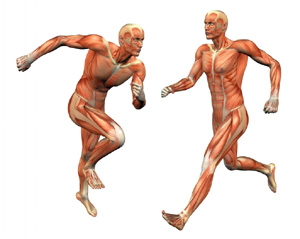What to Expect from Soft Tissue Massage Therapy
Our goal with therapeutic soft tissue massage is to help release muscular tightness, adhesions and “knots” in the muscles which are either specifically causing your condition or contributing to the chronic patterning of your condition (i.e., muscular tightness which is causing spinal vertebrae to remain out of alignment, restricted or subluxated.
When you are having therapeutic soft tissue massage performed, the treatment should not be painful.

However, in order to be effective, the massage should be deep enough to help decrease the muscular tension and release the tight bands and trigger points. Remember, the goal in our office is not relaxation massage (as nice as that is). The day following the soft tissue work, you may experience some soreness (or maybe not at all). If you do experience this, it should pass within 2 days and then you should feel improvement. If you experience soreness for more than 2 days, or you are very sore, you should inform the doctor at your next visit and we will adjust the intensity of the soft tissue work.
The treatment process often takes time to help improve or reduce the knots or adhesions.
Sometimes a few visits suffice and other times it may be a maintenance process to help reduce the size and negative effects of the muscular tightness or trigger points. Prescribed stretching and exercises may be recommended by the doctor and will often augment and speed up the healing process.
Patience with the treatment process in advanced or very chronic cases is often necessary. However, with time, patience, and by adhering to the treatment plan, you should attain success in improving or resolving your condition.
Myofascial Release Therapy
What is Myofascial Pain Syndrome?

Myofascial is the name given to the part of the connective tissue system (fascia) that separates and contains every muscle of the body. Myofascial Pain Syndrome is a chronic pain disorder that results in tight and painful muscles in a specific area with characteristic “trigger points” (knots) in the muscle. These trigger points can cause localized pain or referred pain sent to other areas of the body.
What are trigger points?
They feel like knots or ropey tissue in the muscles. Trigger points develop due to abnormal stress placed upon the muscle (either overload or repetitive stress) and/or due to an incomplete healing process. The accumulation of lactic acid and muscle metabolism waste products help to form the trigger point and the reduced blood flow which develops, perpetuates the trigger point complex. A true trigger point is either locally painful or will elicit a referred pain pattern to a distal (away from the site of the trigger point) location (i.e. down the thigh or arm).
What problems do they cause?
Pain, dysfunction, and disability. Trigger points also restrict freedom of movement by tethering on spinal and extremity joints, thereby causing joint dysfunction.
How do I know if I have Myofascial Pain Syndrome?
If you have chronic, regionalized or referred muscular pain you could develop a myofascial pain syndrome. This condition is initially caused by poor posture, injury, trauma, repetitive or overuse of a body part, lack of exercise and or poor nutrition or metabolic disease.
How can Myofascial Trigger Points (TP) best be treated?
We use specific muscular release therapy to break up TPs, decrease the tension in taut muscle fibers, and increase the blood flow to the area to accelerate the healing process. Studies have shown this is the best treatment for myofascial trigger points. Low-level cold laser therapy and dry needling may also be helpful for resolving chronic muscular problems. We frequently incorporate these treatments as well as chiropractic manipulation, prescribed aerobic exercise, and stretching exercises to bring more oxygen, blood flow, and nutrition to the affected muscles. Myofascial pain syndrome typically doesn’t resolve with medication or muscle strengthening alone. Medication often just hides the pain and can actually perpetuate the condition by not treating the root cause. Chiropractic care and myofascial release can resolve the condition, or at least, greatly improve it.